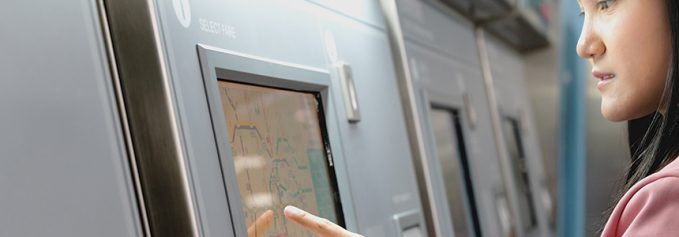
By Digital Output Staff
Media optimized for digital printing with antimicrobial properties spiked in interest during the COVID-19 pandemic. Fabric, film, and vinyl are all available with antimicrobial properties that can protect patrons while out in public. But, not all substrates have this capability. To compensate for base materials that do not exhibit antimicrobial properties, overlaminates are an option.
Above: Drytac Protac AMP Film is a 6-mil textured polyester film.
Getting Science-y
Antimicrobial properties are based on variations in chemical composition, most of which are proprietary by manufacturer. However, there are a few key elements that are common throughout each product.
First Shaun Holdom, global product manager, Drytac, clarifies the meaning of antimicrobial. “Antimicrobial means protection against microbes, which are either bacteria, fungus, or algae. Notice, I didn’t mention virus, as a virus is not a microbe. Microbes are living cells that multiply on any surface to where there is enough cells on a surface to either cause an infection or surface spoilage.”
An antimicrobial coating stops the cells from replicating, protecting the surface and preventing ongoing transmission with active agents or additives. Drytac uses Microban ZPTech, which is an antimicrobial technology incorporated into the laminate’s textured hard coat during the manufacturing process. The main active agent is zinc pyrithione.
Certain additives impede the growth of bacteria, fungus, or algae. For example, KAPCO uses zinc pyrithione and thiabendazole in its products. Another important consideration is where the ingredients are built into the material. KAPCO’s antimicrobial products include them in the vinyl, as opposed to in the top coat. This means they will not rub or scratch off, shares Chuck Noll, VP of sales and marketing, KAPCO.
While antimicrobial films feature a special coating that can inhibit the growth of some bacteria, fungus, or algae, “the limitation of growth, however, does not mean it kills bacteria. Even antimicrobial films should be part of a cleaning regimen,” explains Tony Caruso, regional sales manager, Advanced Greig Laminators, Inc.
“Facilities should continue standard hygiene requirements, but between these combined protocols the surface stays cleaner longer,” agrees Holdom.
Benefiting with Overlams
Print service providers (PSPs) looking to reach certain buyers may want to offer overlaminates with antimicrobial properties. These are used on a range of applications from wall graphics to counter tops.
A print with lamination offers a “premium high-quality appearance. Laminated documents, signage, and prints exemplify dedication and the care businesses put into their operations. Laminated prints are also easier to clean and disinfect,” suggests Taniya Goyal, marketing manager, PFS, GBC North America, an ACCO Brands business.
An overlaminate with antimicrobial features allows a PSP to offer an “additional layer of protection to provide their customers added peace of mind,” says Caruso.
There is also a profit-angle to look at. “Antimicrobials add value to applications where high contact surfaces are involved. In most cases, PSPs can command a premium for this type of upgrade. Their customers may value the extra protection and peace of mind,” says Noll.
Past the Height of Demand
While medical professionals continue to grasp a better understanding on COVID-19, the need for antimicrobial materials remains in some capacity.
It is evident that market demand spiked at the pandemic, comments Holdom, with everyone looking for options to stop the spread of infection. “COVID-19 highlighted the need for hygiene and cleanliness on high-traffic touch points, which require antimicrobial products.”
“We believe there will still be some demand, but barring another pandemic, it is likely to be a fraction of what it was in 2020 and early 2021. Schools, hospitals, and nursing facilities will continue to provide sanitary environments. However, they represent only a small portion of the global market,” shares Noll.
Goyal argues that the demand will flatten after sometime. “Purchasers will keep purchasing the same product as matter of course until the pandemic has been eliminated. After which they may seek less expensive options for finishing.”
“I think more traditional, thermal materials will continue to grow, while antimicrobial films will see a decrease,” agrees Caruso. A polyester thermal film can be sanitized using disinfecting wipes or cleaners. Another plus of thermal laminates—they are attractively priced.
Real Life Use
Globe Print of the U.K. was tasked with a multi-application project by Newdays Pharmacy in early 2021 for a new vaccination center in Marlow, Buckinghamshire. The PSP relied on Drytac media to produce internal wall graphics, signage, clear internal wall partition signage, and floor graphics; as well as exterior floor graphics.
Globe Print worked with Drytac Protac AMP Film, which incorporates Microban antimicrobial protection, for any of the graphics located at high-traffic touch points in the facility, this included doors and handles.
An Overlaminate Resurgence
Graphics requiring frequent cleaning are more apt to stand up to sanitation practices with a protective overlaminate. While overlaminates with antimicrobial features are less in demand, it is comforting to know the option is there.
Oct2021, Digital Output


